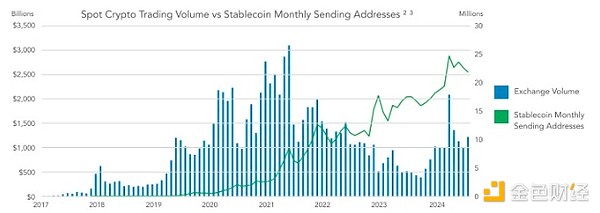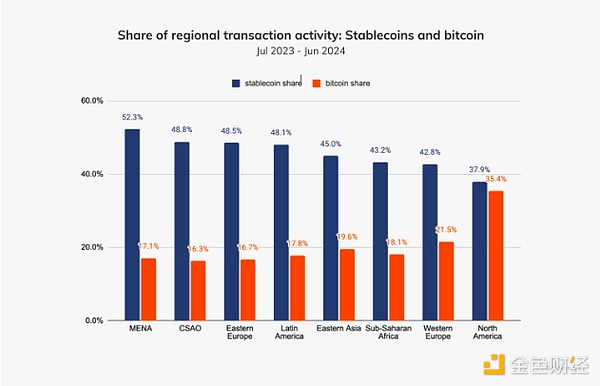Author: David Feliba, CoinTelegraph; Translated by: Bai Shui, Jinse Finance
While the Trump administration laid the groundwork for cryptocurrency regulation in the US (with the White House's new crypto czar expected to set the direction in the coming months), these digital assets have been thriving in emerging markets.
Stablecoins pegged to fiat currencies are becoming an important financial tool in many developing countries, driving remittances and cross-border trade, bridging financial inclusion gaps, and providing inflation hedges in nations where traditional banking is often lacking and hundreds of millions have virtually no access to financial services.
Stablecoins (primarily pegged to the US dollar) have seen explosive growth in recent years, with their real-world use cases rapidly expanding into Africa, Latin America, and parts of Asia. While the US is still studying how to apply this technology beyond the crypto realm, emerging markets have already proven the importance of stablecoins.
In these regions, they are not just a financial experiment, but a solution.
Stablecoins as an Inflation Hedge in South America
In inflation-plagued economies like Argentina and Venezuela, stablecoins provide a US dollar-pegged safe haven to avoid local currency devaluation, especially when foreign exchange channels are tightly controlled. Across Africa and Central America, they are a cost-effective tool for remittances and cross-border payments, while in places like Indonesia, they can offer an easier-to-access alternative to traditional US dollar banking, which may involve complex requirements.
Eswar Prasad, a professor of trade policy at Cornell University, said that while in wealthier, more developed economies, stablecoins are primarily used for decentralized finance and as a bridge between traditional banking and DeFi, in emerging markets with limited financial infrastructure, their role is more fundamental and indispensable.
"In low- and middle-income economies with underdeveloped financial systems, they can play a beneficial role in providing a convenient, widespread, low-cost digital payments system for citizens and businesses."
The US dollar is widely seen as a global store of value, and access to dollars is a key driver for emerging markets adopting stablecoins. In contrast to the volatility of early cryptocurrencies like Bit, stablecoins aim to provide stability, with most pegged to the US dollar, led by USDT Tether with nearly 60% global market share, followed by another US dollar-backed asset, USDC.

Stablecoins issued by providers. Source: Castle Island Ventures.
"There are some problems in the world that need to be solved with a cryptocurrency that doesn't constantly fluctuate in price," said Julián Colombo, a senior executive at the Mexican cryptocurrency exchange Bitso, which has official offices in Argentina, Brazil, and Colombia.
"Stablecoins provide a way to bring all the benefits of cryptocurrencies into real-world use cases - not just the potential to get rich off Bit."
Stablecoins a Top Priority for Trump's Crypto Czar
The momentum around stablecoins in the US is building, with bipartisan senators proposing legislation on February 4th to establish a regulatory framework. David Sacks, the White House's AI and cryptocurrency czar, emphasized in his first public address to the industry that stablecoin regulation is a top government priority, with the former venture capitalist-led task force drafting key policies within the next six months.
Nonetheless, the growth of stablecoins has been nothing short of astounding. According to DeFiLlama data, their market cap has reached a staggering $100 billion in just the past year, soaring to $225 billion as of February 2025. USDT remains dominant, accounting for over 60% of the market, but challengers - including those backed by financial giants like PayPal - are rapidly emerging.
"Stablecoins - tokenized representations of fiat currencies circulating on blockchains - are undoubtedly the 'killer app' of cryptocurrencies," a report written by Castle Island Ventures and sponsored by VISA stated.
"We believe stablecoins represent a payments innovation that has the potential to bring secure, reliable, and convenient payment services to more people in more places," said Cuy Sheffield, the US payments giant's global head of crypto.
The report noted: "While they initially emerged as crypto-native collateral types and settlement mediums for traders and exchanges, they have crossed the chasm and are seeing widespread adoption in the broader global economy."
"The divergence between stablecoin activity and crypto market cycles makes it clear that stablecoin adoption has gone beyond merely serving crypto users and use cases."

Spot crypto trading volume vs. monthly active stablecoin addresses. Source: Castle Island Ventures.
Stablecoins have gained significant traction in emerging markets as a store of value, inflation hedge, and tool for cross-border transactions. A recent Chainalysis report found that in regions like Africa, Eastern Europe, Latin America, and Asia, stablecoin adoption far outpaces Bit, accounting for nearly half of all crypto transactions in some cases.
In contrast, the US and North America have the lowest stablecoin adoption rates, although it still holds a sizable share.

Regional transaction activity shares: stablecoins and Bit. Source: Chainalysis.
Gabriel Galipolo, the president of Brazil's central bank, stated that in places like Brazil, the use of stablecoins has grown significantly in recent years. Brazil, a powerhouse in Latin America with a population of 216 million and a GDP of $2.2 trillion, saw up to 90% of the entire crypto circulation related to stablecoins, according to the economist at the International Monetary Fund event in Mexico City on February 6th.
"A large part of that is for buying things and shopping from abroad," Galipolo said, emphasizing the new trend poses serious regulatory challenges around taxation.
However, Julián Colombo, who leads the local operations of the regional exchange Bitso, said that in Latin America, no place embraces stablecoins more than Argentina. In the face of the country's long-term inflation and economic instability, they provide a crucial financial haven for citizens.
Colombo stated: "In Argentina, just like in other high-inflation countries, stablecoins have become a solution to a very real and pressing problem."
"Argentinians don't trust the local currency and prefer to save in US dollars, but government-imposed foreign exchange controls and restrictions make it difficult to access dollars. Stablecoins fill that gap, providing a way to hold and transact in dollars."
He said that in Argentina, around two-thirds of the crypto purchased through exchanges is in US dollar-pegged assets. While Argentina's financial indicators have improved under the market-driven government of President Javier Milei, inflation still stands at 84.5%.
Although recent monthly data shows a downward trend, rebuilding trust in the local currency in a country long plagued by triple-digit inflation and severe currency devaluation will take time to ensure the sustained demand for US dollar-linked stablecoins.
Here is the English translation:Similarly, the adoption of such digital assets is also of great significance to Venezuela, a country that has long suffered from high inflation and extensive regulation, making it very difficult to obtain foreign currencies such as the US dollar. In emerging markets with relatively stable currencies such as Brazil or Mexico, they can play different but equally important roles: enabling fast, low-cost remittances without the volatility of traditional cryptocurrencies.
Businesses use them to pay for international service fees, hire remote employees, send dividends, and facilitate remittances, making cross-border transactions more efficient and convenient.
"Compared to other crypto assets, stablecoins have the promise of stability," the Bank for International Settlements said in a report on stablecoins. "Due to this potential, they are increasingly entering the mainstream of finance, and many jurisdictions have developed regulatory approaches for stablecoin issuers pegged to a single fiat currency."
Stablecoins Drive Remittances in Central America and Africa
One of the most powerful use cases of stablecoins is cross-border transfers and remittances, especially in Central America and Africa, where these digital assets provide a cheaper and faster alternative for cross-border capital flows. Immigrants working in the US often find stablecoins to be a more convenient tool for sending money back home to their families.
"Stablecoins have gained some attention in both domestic and cross-border payments," said Prasad, a professor of trade policy at Cornell University in the US, to Cointelegraph. "They have been particularly useful in overcoming the inefficiency, high costs, and slow processing times associated with cross-border transactions through traditional payment channels."
Commenting on the proliferation of stablecoins in remittances, Colombo said, "Before cryptocurrencies, remittance services might charge up to 10% just to send money from one country to another. Using cryptocurrencies, you might have some extra money to remit to Mexico, and the transfer might only cost a penny - it can arrive in a matter of minutes, not hours or days."
More Cases of Non-Crypto Use of Stablecoins
In a Visa-sponsored report, researchers surveyed about 500 cryptocurrency users in Nigeria, Indonesia, Turkey, Brazil, and India, totaling 2,541 adults. While acquiring cryptocurrencies remains the most popular motivation for using them, non-crypto uses such as obtaining US dollars, generating yields, or trading purposes are also very popular.

Stablecoin survey results. Source: Castle Island Ventures.
The survey shows that Nigerian users have the strongest affinity for stablecoins compared to the other surveyed countries. Nigerians have the highest frequency of transacting with stablecoins, the largest share of stablecoins in their portfolios, use them for the widest range of non-crypto purposes, and self-report the highest level of understanding of stablecoins. Saving US dollars is their top priority.
Zekarias Dubale, co-founder of the Africa Fintech Summit, said that across Africa, stablecoins have become the "holy grail" for cross-border trade, international remittances, and value transfer across the entire African continent. He believes these digital assets can provide the financial infrastructure needed to facilitate global trade.
However, stablecoins are not without risk. While the most widely used stablecoins have largely maintained their peg to the strong fiat currencies they are intended to reflect, the market is rapidly expanding, with hundreds of digital assets currently in circulation. However, many of these assets lack the transparency of the reserves supporting them, and instances of stablecoin de-pegging and even collapse have occurred in some cases.
Nevertheless, in the US under the Trump administration and in emerging markets, the development of stablecoins has been gaining momentum, proving to be a powerful tool to help citizens overcome challenges related to financial inclusion and underdeveloped infrastructure.






